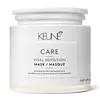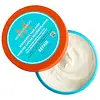What's inside
What's inside
 Key Ingredients
Key Ingredients

 Benefits
Benefits

 Concerns
Concerns

 Ingredients Side-by-side
Ingredients Side-by-side

Water
Skin ConditioningCetearyl Alcohol
EmollientBehentrimonium Methosulfate
Glycerin
HumectantOctyldodecanol
EmollientCetrimonium Chloride
AntimicrobialAmodimethicone
Hydrolyzed Wheat Protein
Skin ConditioningSodium Benzoate
MaskingHydrolyzed Vegetable Protein Pg-Propyl Silanetriol
Skin ConditioningLactic Acid
BufferingParfum
MaskingPropylene Glycol
HumectantTrideceth-12
EmulsifyingPhenoxyethanol
PreservativeBenzoic Acid
MaskingPotassium Sorbate
PreservativeSaccharomyces/Magnesium Ferment
Saccharomyces/Iron Ferment
Skin ConditioningSaccharomyces/Zinc Ferment
Skin ConditioningSaccharomyces/Copper Ferment
Skin ConditioningSaccharomyces/Silicon Ferment
Skin ConditioningCI 14700
Cosmetic ColorantCI 19140
Cosmetic ColorantLimonene
PerfumingLinalool
PerfumingWater, Cetearyl Alcohol, Behentrimonium Methosulfate, Glycerin, Octyldodecanol, Cetrimonium Chloride, Amodimethicone, Hydrolyzed Wheat Protein, Sodium Benzoate, Hydrolyzed Vegetable Protein Pg-Propyl Silanetriol, Lactic Acid, Parfum, Propylene Glycol, Trideceth-12, Phenoxyethanol, Benzoic Acid, Potassium Sorbate, Saccharomyces/Magnesium Ferment, Saccharomyces/Iron Ferment, Saccharomyces/Zinc Ferment, Saccharomyces/Copper Ferment, Saccharomyces/Silicon Ferment, CI 14700, CI 19140, Limonene, Linalool
Water
Skin ConditioningCetearyl Alcohol
EmollientBehentrimonium Chloride
PreservativeCanola Oil
EmollientButyrospermum Parkii Butter
Skin ConditioningParfum
MaskingDimethicone
EmollientArgania Spinosa Kernel Oil
EmollientCaryocar Brasiliense Fruit Oil
Skin ConditioningHydrolyzed Vegetable Protein Pg-Propyl Silanetriol
Skin ConditioningGuar Hydroxypropyltrimonium Chloride
Skin ConditioningTocopherol
AntioxidantSorbitan Oleate
EmulsifyingPEG-60 Almond Glycerides
EmulsifyingCeteareth-20
CleansingPolyquaternium-37
PPG-1 Trideceth-6
Skin ConditioningQuaternium-98
EmollientSteareth-2
EmulsifyingCitric Acid
BufferingDimethiconol
EmollientAcrylates Copolymer
Caprylyl Glycol
EmollientIsopropyl Alcohol
SolventAcetamide Mea
HumectantDisodium EDTA
Chlorphenesin
AntimicrobialPropylene Glycol Dicaprylate/Dicaprate
EmollientStearamidopropyl Dimethylamine
EmulsifyingPolyacrylamidopropyltrimonium Chloride
Dihydrogenated Tallow Hydroxyethylmonium Methosulfate
Potassium Sorbate
PreservativeBHT
AntioxidantPhenoxyethanol
PreservativeAlpha-Isomethyl Ionone
PerfumingLinalool
PerfumingHydroxycitronellal
PerfumingWater, Cetearyl Alcohol, Behentrimonium Chloride, Canola Oil, Butyrospermum Parkii Butter, Parfum, Dimethicone, Argania Spinosa Kernel Oil, Caryocar Brasiliense Fruit Oil, Hydrolyzed Vegetable Protein Pg-Propyl Silanetriol, Guar Hydroxypropyltrimonium Chloride, Tocopherol, Sorbitan Oleate, PEG-60 Almond Glycerides, Ceteareth-20, Polyquaternium-37, PPG-1 Trideceth-6, Quaternium-98, Steareth-2, Citric Acid, Dimethiconol, Acrylates Copolymer, Caprylyl Glycol, Isopropyl Alcohol, Acetamide Mea, Disodium EDTA, Chlorphenesin, Propylene Glycol Dicaprylate/Dicaprate, Stearamidopropyl Dimethylamine, Polyacrylamidopropyltrimonium Chloride, Dihydrogenated Tallow Hydroxyethylmonium Methosulfate, Potassium Sorbate, BHT, Phenoxyethanol, Alpha-Isomethyl Ionone, Linalool, Hydroxycitronellal
Ingredients Explained
These ingredients are found in both products.
Ingredients higher up in an ingredient list are typically present in a larger amount.
Cetearyl alcohol is a mixture of two fatty alcohols: cetyl alcohol and stearyl alcohol. It is mainly used as an emulsifier. Emulsifiers help prevent the separation of oils and products. Due to its composition, it can also be used to thicken a product or help create foam.
Cetearyl alcohol is an emollient. Emollients help soothe and hydrate the skin by trapping moisture.
Studies show Cetearyl alcohol is non-toxic and non-irritating. The FDA allows products labeled "alcohol-free" to have fatty alcohols.
This ingredient is usually derived from plant oils such as palm, vegetable, or coconut oils. There is debate on whether this ingredient will cause acne.
Due to the fatty acid base, this ingredient may not be Malassezia folliculitis safe.
Learn more about Cetearyl AlcoholWe don't have a description for Hydrolyzed Vegetable Protein Pg-Propyl Silanetriol yet.
Linalool is a fragrance and helps add scent to products. It's derived from common plants such as cinnamon, mint, citrus, and lavender.
Like Limonene, this ingredient oxidizes when exposed to air. Oxidized linalool can cause allergies and skin sensitivity.
This ingredient has a scent that is floral, spicy tropical, and citrus-like.
Learn more about LinaloolParfum is a catch-all term for an ingredient or more that is used to give a scent to products.
Also called "fragrance", this ingredient can be a blend of hundreds of chemicals or plant oils. This means every product with "fragrance" or "parfum" in the ingredients list is a different mixture.
For instance, Habanolide is a proprietary trade name for a specific aroma chemical. When used as a fragrance ingredient in cosmetics, most aroma chemicals fall under the broad labeling category of “FRAGRANCE” or “PARFUM” according to EU and US regulations.
The term 'parfum' or 'fragrance' is not regulated in many countries. In many cases, it is up to the brand to define this term.
For instance, many brands choose to label themselves as "fragrance-free" because they are not using synthetic fragrances. However, their products may still contain ingredients such as essential oils that are considered a fragrance by INCI standards.
One example is Calendula flower extract. Calendula is an essential oil that still imparts a scent or 'fragrance'.
Depending on the blend, the ingredients in the mixture can cause allergies and sensitivities on the skin. Some ingredients that are known EU allergens include linalool and citronellol.
Parfum can also be used to mask or cover an unpleasant scent.
The bottom line is: not all fragrances/parfum/ingredients are created equally. If you are worried about fragrances, we recommend taking a closer look at an ingredient. And of course, we always recommend speaking with a professional.
Learn more about ParfumPhenoxyethanol is a preservative that has germicide, antimicrobial, and aromatic properties. Studies show that phenoxyethanol can prevent microbial growth. By itself, it has a scent that is similar to that of a rose.
It's often used in formulations along with Caprylyl Glycol to preserve the shelf life of products.
Potassium Sorbate is a preservative used to prevent yeast and mold in products. It is commonly found in both cosmetic and food products.
This ingredient comes from potassium salt derived from sorbic acid. Sorbic acid is a natural antibiotic and effective against fungus.
Both potassium sorbate and sorbic acid can be found in baked goods, cheeses, dried meats, dried fruit, ice cream, pickles, wine, yogurt, and more.
You'll often find this ingredient used with other preservatives.
Learn more about Potassium SorbateWater. It's the most common cosmetic ingredient of all. You'll usually see it at the top of ingredient lists, meaning that it makes up the largest part of the product.
So why is it so popular? Water most often acts as a solvent - this means that it helps dissolve other ingredients into the formulation.
You'll also recognize water as that liquid we all need to stay alive. If you see this, drink a glass of water. Stay hydrated!
Learn more about Water